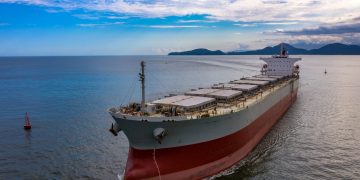Fuel Saving Guidelines for Bulk Carriers
 The combination of low charter rates and high fuel prices is creating a strong interest in fuel saving measures. DNV has now updated the Fuel Saving Guideline for Bulk Carriers, which was released in April this year, and has issued three new guidelines covering tank, bulk, and container vessels.
The combination of low charter rates and high fuel prices is creating a strong interest in fuel saving measures. DNV has now updated the Fuel Saving Guideline for Bulk Carriers, which was released in April this year, and has issued three new guidelines covering tank, bulk, and container vessels.
DNV released the first version of the Fuel Saving Guideline for Bulk Carriers in April this year. “The very positive reception we received from owners and operators of bulk carriers have prompted us to prepare an updated guideline which covers more areas in even more detail. The need for objective guidance is very strong in the current situation with low rates and high fuel prices,” says Michael Aasland, DNV’s Business Director for Bulk Carriers.
DNV has now also issued three separate guidelines, each covering a major ship type.
“The tanker version of the Fuel Saving Guideline provides an easy overview of different fuel saving alternatives for tankers, with their typical operation profile – both existing vessels and new designs. Tanker charterers, which are frequently paying the fuel bill, are likely to include IMO’s Energy Efficiency Design Index (EEDI), now that this has been implemented for new vessels contracted from 1 January 2013, as one element in their vetting process. DNV’s Guideline with the associated Investment Calculator and advisory services may therefore offer highly relevant input and decision support for designers, yards and owners involved with tankers,” says Jan Koren, DNV’s Business Director for Tankers.
“Fuel is a major cost element for container ships. Slow steaming and reduced container volumes make it more important than ever to choose the right measures to reduce the fuel consumption. The new operational profile will influence the new designs and what fuel saving measures to implement. But also retrofits on older designs will be on the agenda of many owners.” says Jost Bergman, DNV’s Business Director for Containers.
The new guides are a result of a co-operatoin between HSVA and DNV, and for the bulk carrier guide also SDARI has been involved. The new guidelines also cover the impact of each fuel saving measure on both the EEDI and the EEOI, which was passed by IMO at MEPC 62.
An additional Return on Investment Calculator makes it possible to perform an economic analysis based on future fuel prices and interest rate scenarios and estimate the reduction in fuel consumption, as well as the investment and maintenance costs. The calculator then gives the net present value, rate of return and payback period of an investment in fuel saving devices.
To assist owners further, DNV is also offering advisory services to ship owners and operators, in addition to the three Guidelines and the Return on Investment Calculator which are offered free of charge to customers. The advisory services cover a wide range, from the initial screening of suitable devices to verification of the effect of the advice based on advanced Computational Fluid Dynamic (CFD) calculations.
“Through the new guidelines for tank, bulk and container vessels, we hope to make it easier for owners and operators to save costs, improve their environmental performance and become more competitive in a very tough market,” says Trond Hodne, DNV’s Business Director Maritime.
Source: DNV






























































